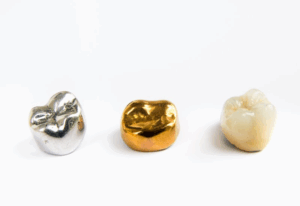Everything You Need to Know About Temporary Crowns
January 30, 2019

It might seem unnecessary, but rest assured, a temporary crown is an integral part of the dental crown process. Also known as a “provisional crown” or “interim crown,” a temporary crown is used to protect a damaged tooth while the permanent version is being made in the lab. Without it, your vulnerable pearly white would be at an increased risk for infection, cavities, gum disease, and other unpleasant complications!
To learn everything you need to know about temporary crowns, keep reading.
Why Do I Need a Temporary Crown?
Before a dental crown can be placed, your tooth has to be prepared. Your dentist in Idaho falls will carefully reshape your tooth, filing down the sides and top to create a smooth surface for the permanent crown to adhere to. Afterward, they will take an impression of the filed tooth and send it to a dental lab, where skilled technicians will use the measurements to customize your permanent crown.
It can take at least two weeks for the permanent crown to be ready. During that time, you don’t want an already weakened tooth to go without protection. So, while you wait, your dentist has to place a temporary crown onto your tooth to protect it from further damage or decay. Besides preserving your precious pearly white, a temporary crown also prevents surrounding teeth from shifting, shapes the gum tissue properly, prevents sensitivity, and helps maintain your dental aesthetics.
How Should I Care for My Temporary Crown?
Since temporary crowns are, well, temporary, they’re not as durable as your permanent restoration will be. You shouldn’t eat within 30 minutes of receiving your temporary crown so that the cement has time to set. When you get hungry, avoid eating especially sticky, chewy, or crunchy foods, as they could pull the crown loose or damage its chewing surface. Instead stick to soft treats like ice cream, berries, soup, and steamed vegetables.
It’s also important to continue brushing your teeth twice daily and flossing at least once per day. Developing a cavity or gum disease would not only be unpleasant, but also throw off the fit of your permanent crown!
What Should I Do if My Temporary Crown Falls Out?
If your temporary crown falls out, call your emergency dentist in Idaho Falls immediately. You may not necessarily need same-day care, but it’s risky to leave a weakened tooth exposed for prolonged periods of time. Depending on how damaged the crown is, your dentist may recommend trying to reseat it with toothpaste or a special dental adhesive. Whatever the case may be, do not attempt to use regular glue!
In Conclusion
Temporary crowns protect the tooth underneath from further damage or decay while your permanent crown is being crafted. As a vital part of the dental crown process, you should take good care of your temporary crown, and let your dentist know right away if it falls out or becomes chipped or cracked. Before you know it, your dentist will be calling you back to the office to receive your beautifully customized (and permanent!) restoration.
About the Author
Dr. Brent Cline has a wealth of advanced training in several dental treatments, including restorations. He highly values quality patient care, so if you need a dental crown near Idaho Falls, you can trust that Dr. Cline will listen attentively to your needs and address any questions or concerns you may have. To learn more about temporary crowns or schedule an appointment, you can call Dr. Cline’s office at 208-487-5987 or submit your request online.

